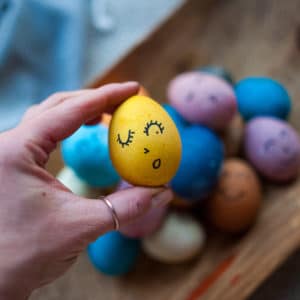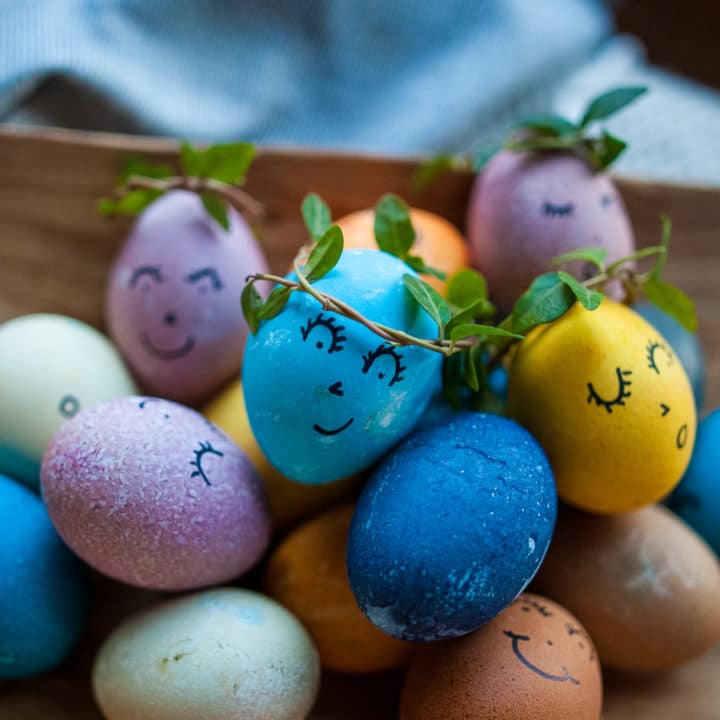We love these Naturally Dyed Easter Eggs! They’re colored with common foods and spices, so they are naturally safe and non-toxic. Plus they’re really pretty and so much fun to make.
 It’s April now and Easter is right around the corner! If you can get your hands on a dozen or two of eggs, coloring them with natural dye is such fun! And these Naturally Dyed Easter Eggs may save you a trip to the store since you won’t need to buy a kit, which is an added bonus this year. Read on, and we’ll explain what foods and spices to use to create your own natural dyes and how to dye your eggs.
It’s April now and Easter is right around the corner! If you can get your hands on a dozen or two of eggs, coloring them with natural dye is such fun! And these Naturally Dyed Easter Eggs may save you a trip to the store since you won’t need to buy a kit, which is an added bonus this year. Read on, and we’ll explain what foods and spices to use to create your own natural dyes and how to dye your eggs.
What is needed for Naturally Dyed Easter Eggs
- Eggs – White or brown eggs will work, but the shell color will affect the way the dye appears. Brown eggs will result in darker and more earthy tones and white eggs will be more vibrant and colorful. The color and type of egg you use is up to you, but they will need to be hardboiled first. I used an Instant Pot to hard-boil mine, but there are many methods to hard-boil eggs. Allow the eggs to cool completely before dyeing them.
- Food and spices – Take a peak in your fridge and your spice cabinet. Don’t make a special run to the store for something you don’t already have, but you probably have several items on hand that will make natural dyes. Beets, cabbage, carrots, spinach, onion skins, coffee, turmeric, and paprika all work well. Check out the next section for specifics. Many are similar to the dyes we used in the DIY Paint post last week.
- Vinegar – White distilled vinegar helps the color attach to the shell. You’ll need about 2 tablespoons of vinegar for each dye.
- Small jars – We used 8 oz. jam jars to separate individual dyes. They were large enough for one egg to sit in at a time. You could use bowls or larger jars or cups as well.

How to make naturally dyed easter eggs
- Red/Pink – Beets create a beautiful vibrant pinkish red color. Take one whole raw beet and dice it into 1/2 inch cubes. Place the cubes in a small sauce pan and cover with about 1 cup of water. Heat until boiling and then simmer for about 15 minutes. Remove the beets and save the liquid. Pour liquid into a small glass jar and add 2 tablespoons of vinegar. Add an egg and soak for at least 15 to 30 minutes or longer. The longer you soak, the more vibrant the color becomes.
- Orange – Carrots make a beautiful orange color and most likely, even during this pandemic, you still have a few carrots in your fridge! Dice 1 medium carrot into small pieces and place them in the food processor. Pulse on high for about one minute or until the carrot is in tiny, rice-size pieces. Scrape the sides, add a splash of hot water and pulse again until you have mushy, mostly pureed carrots. Transfer to a cloth and squeeze the liquid into a bowl. Heat up and add 2 tablespoons of vinegar. The eggs need to sit in the orange dye for 60 minutes or more before the color begins to attach. Onion skins also work great for orange.
- Yellow – Ground turmeric works the best for yellow, but curry powder could be used as well. Add 1/2 teaspoon of ground turmeric to 1 cup of boiling water. Mix to combine and add 2 tablespoons of vinegar. Drop an egg in the jar and let sit for at least 15 minutes, but the longer you leave it, the more vibrant the color becomes.
- Green – There are a couple ways you could make green dye. First, place 1 cup of spinach and 1 cup of water in a saucepan. Heat to boiling and reduce for about 15 minutes. Drain and keep the green liquid. Add 2 tablespoons of vinegar. Or add 1 teaspoon of spinach or kale powder to 1 cup of boiling water. Mix to combine and an add 2 tablespoons of vinegar. I had kale powder left over from our Shamrock Wall Hangings project, which is what we used. The egg will need to sit in the dye for 1 or 2 hours before it takes on a green hue.
- Blue – Red cabbage makes such a pretty blue color! Finely chop a 1/2 cup of red cabbage. Add the cabbage and 1 cup of water to a small saucepan. Bring to a boil and simmer for 10 minutes. Drain the cabbage and save the liquid. Add 2 tablespoons of vinegar and let the egg soak for at least 20 minutes, but the longer it sits the more vibrant the color becomes.
- Purple – Blueberries make a deep purple/blue color. Add about a 1/2 cup of frozen blueberries and 1/2 cup of water to a small saucepan and bring to a boil. Cook over medium heat and mash the berries with a fork as they simmer for about 10 minutes. Then, pour the soft, mashed blueberries into a strainer to remove seeds and skins and only keep the liquid. Add 2 tablespoons of vinegar and let the egg soak for about 30-60 minutes.
- Brown – Coffee works best for brown, but black tea would work as well. Heat 1 cup of coffee (we used leftover coffee from that morning) and add 2 tablespoons of vinegar. Let the egg sit for 30 minutes or longer.

Other ways to decorate your Naturally Dyed Easter Eggs
- Add faces – Grab a fine tipped black Sharpie and draw a few funny faces onto your eggs. I was originally inspired by Fox Meets Bear‘s flower crowned eggs. They’re so cute!

- Add crowns – We cut off a 6-8 inch long leafy vine and twisted them onto themselves to create a circle. Twist the ends around each other to create a sweet little crown. Place on top of your egg face.

- Add designs – Once the eggs dry, you could use a marker to add designs or decorate with stickers.


How to Make Naturally Dyed Easter Eggs
We love these Naturally Dyed Easter Eggs! They're colored with common foods and spices, so they are naturally safe and non-toxic. Plus they're really pretty and so much fun to make.
Materials
- Eggs
- Various Foods & Spices
- Vinegar
- Water
Tools
- Saucepan
- Food Processor
- Strainer
- Measuring Cups
- Measuring Spoons
- Spoons
- Knife
- Cutting Board
- 8 ounce jam jars
Instructions
RED/PINK – Beets create a beautiful vibrant pinkish red color. Take one whole raw beet and dice it into 1/2 inch cubes. Place the cubes in a small sauce pan and cover with about 1 cup of water. Heat until boiling and then simmer for about 15 minutes. Remove the beets and save the liquid. Pour liquid into a small glass jar and add 2 tablespoons of vinegar. Add an egg and soak for at least 15 to 30 minutes or longer. The longer you soak, the more vibrant the color becomes.
ORANGE – Carrots and onion skins make a beautiful orange color. If using carrots, dice 1 medium carrot into small pieces and place them in the food processor. Pulse on high for about one minute or until the carrot is in tiny, rice-size pieces. Scrape the sides, add a splash of hot water and pulse again until you have mushy, mostly pureed carrots. Transfer to a cloth and squeeze the liquid into a bowl. Heat up and add 2 tablespoons of vinegar. The eggs need to sit in the orange dye for 60 minutes or more before the color began to attach. Onion skins also work great for orange. If using onion skins, boil in 1 cup of water for 15 minutes. Drain and save liquid. Add vinegar and let the eggs soak until desired color is reached.
YELLOW – Ground turmeric works the best for yellow, but curry could be used as well. Add 1/2 teaspoon of ground turmeric to 1 cup of boiling water. Mix to combine and add 2 tablespoons of vinegar. Drop an egg in the jar and let sit for at least 15 minutes, but the longer you leave it, the more vibrant the color becomes.
GREEN – Spinach and kale work well to make green dye. First, place 1 cup of spinach and 1 cup of water in a saucepan. Heat to boiling and reduce for about 15 minutes. Drain and keep the green liquid. Add 2 tablespoons of vinegar. Or add 1 teaspoon of spinach or kale powder to 1 cup of boiling water. Mix to combine and an add 2 tablespoons of vinegar. The egg will need to sit in the dye for 1 or 2 hours before it takes on a green hue.
BLUE – Red cabbage makes such a pretty blue color! Finely chop a 1/2 cup of red cabbage. Add the cabbage and 1 cup of water to a small saucepan. Bring to a boil and simmer for 10 minutes. Drain the cabbage and save the liquid. Add 2 tablespoons of vinegar and let the egg soak for at least 20 minutes, but the longer it sits the more vibrant the color becomes.
PURPLE – Blueberries make a deep purple/blue color. Add about a 1/2 cup of frozen blueberries and 1/2 cup of water to a small saucepan and bring to a boil. Cooked over medium heat and mash the berries with a fork as they simmer for about 10 minutes. Then, pour the soft, mashed blueberries into a strainer to remove seeds and skins and only keep the liquid. Add 2 tablespoons of vinegar and let the egg soak for about 30-60 minutes.
BROWN - Coffee works best for brown, but black tea would work as well. Heat 1 cup of coffee and add 2 tablespoons of vinegar. Let the egg sit for 30 minutes or longer.

Leave a Reply